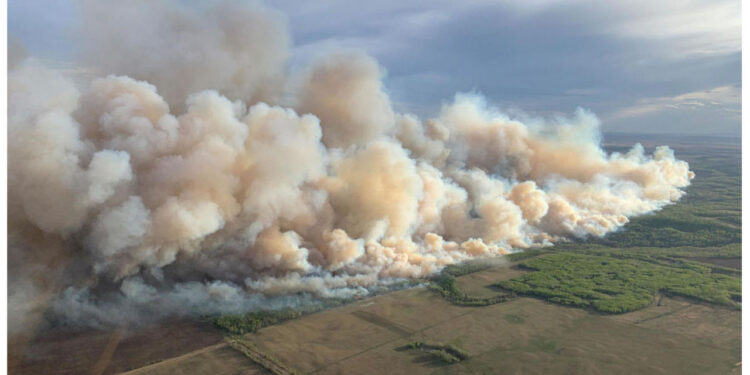Thousands of residents in a Canadian town are being advised to evacuate due to a rapidly spreading wildfire. The fire has caused a decline in air quality and limited visibility in the area.
A fire broke out in northeastern British Columbia on Friday and rapidly intensified, covering an area of approximately 4,200 acres by the next day. BC Wildfire Service maps indicate that the fire is currently burning in close proximity to the city limits of Fort Nelson. Situated in the far northeastern region of British Columbia, Fort Nelson is located around 995 miles away from Vancouver. The combined population of Fort Nelson and the Fort Nelson Indian Reserve is approximately 3,000 residents.
According to a Sunday alert, the smoke from the wildfires in British Columbia is leading to widespread issues with air quality and reduced visibility.
Locals in Fort Nelson were quick to share online footage of the wildfire, capturing the dramatic scene as thick plumes of smoke billowed into the sky. These photos showcased houses in the foreground, with the haze appearing to envelop large areas.
The Northern Rockies Regional Municipality and Fort Nelson First Nation have released a joint statement cautioning individuals who choose to remain that they will not have access to emergency medical services, groceries, or other amenities.
According to the municipality mayor, Rob Fraser, the majority of residents in and around Fort Nelson have been evacuated. He mentioned that police are currently going door to door to ensure that everyone has safely left their homes.
Fraser emphasized the importance of unity in times of uncertainty. In a press release, he urged everyone to evacuate calmly, highlighting that our collective strength will be the key to our resilience.
The health authorities have announced the safe evacuation and temporary closure of Fort Nelson General Hospital.
Authorities in Alberta have issued an alert regarding a wildfire located 15.5 miles southwest of Fort McMurray, the city known for its oil sands. The authorities have warned that the wildfire may affect visibility on highways in certain areas. However, no evacuation order has been issued for this significant Canadian oil city at this point in time.
Officials have stated that fire restrictions will continue to be enforced in the area until conditions improve.
According to Alberta Wildfire, the wildfire on the southeast perimeter was tackled by five crews of wildland firefighters, along with nine helicopters and air tankers. Despite challenging windy conditions, efforts were made to control the fire. The incident management team will continue to oversee the situation.
On Saturday, strong winds swept smoke across Alberta, leading to an air quality advisory in the city of Edmonton. The hazard levels were rated at 10-plus, indicating a “very high risk” forecast.
According to meteorologists, there is no rain expected, and they are recommending people to remain indoors.
Officials have stated that although conditions are expected to improve on Sunday night, they are likely to remain poor throughout Monday or possibly even Tuesday.
Canadian officials have issued a warning, stating that individuals with lung diseases like asthma, heart disease, older adults, children, pregnant women, and those who work outdoors are more susceptible to health issues caused by wildfire smoke. To minimize exposure to harmful fire particles in the smoke, they advise individuals who spend time outside to wear masks.
Officials have emphasized that even at low concentrations, wildfire smoke can pose a threat to everyone’s health.
Officials have revealed that Canada experienced warmer-than-normal temperatures and widespread drought conditions during the winter. Weather forecasts suggest that the country can anticipate higher-than-normal temperatures during the upcoming spring and summer seasons, which could potentially lead to an increased risk of wildfires.
“We can anticipate an earlier start and a prolonged end to the wildfire season, with the possibility of more intense fire outbreaks due to the prevailing heat and dry conditions,” stated Harjit Sajjan, the Minister of Canada Emergency Preparedness, during a press conference.
Canada experiences its annual wildfire season from May through October. With approximately 9% of the world’s forests located within its borders, the country is known for its vast wilderness and natural beauty.
In 2023, an unprecedented surge in wildfires occurred in Canada, which resulted in severe smoke and prompted the evacuation of tens of thousands of individuals in British Columbia. The impact of these wildfires extended beyond the Canadian borders, as 19 counties in 11 states within the United States experienced multiple days of “very unhealthy” and “hazardous” air quality.
Smoke filled the skies across the United States, enveloping parts of the East Coast and Midwest. In a particularly alarming incident last June, New York City experienced a severe decline in air quality, ranking among the worst in the world. This was due to the smoke emanating from the wildfires in Canada that had drifted towards the city.
According to officials, severe weather in Canada in 2023 led to insured damages exceeding $3.1 billion.










